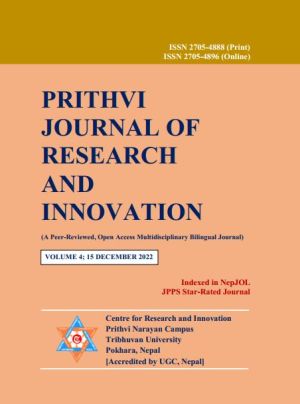Determination of Chemical Parameters of Fruits Available in the Markets of Pokhara, Nepal
DOI:
https://doi.org/10.3126/pjri.v4i1.50151Keywords:
Antioxidant, apple, chemical constituents, colorimeter, dietary fibreAbstract
The main objective of this paper is to determine the chemical parameters: pH, optical density (OD), electrical conductivity (EC), percentage of moisture content, total ash, silica, dietary fiber, total acid, vitamin C, total reducing sugar, and formaldehyde content, of selected fruits (apple, banana, coconut, grape, litchi, mango, mousambi, papaya, pineapple, pomegranate and watermelon) available in the markets of Pokhara. Chemical parameters were analyzed by using standard methods in the Research Laboratory of Prithvi Narayan Campus Pokhara, Nepal from 15th March 2022 to 14th June 2022. The pH content ranged from 3.17 to 5.40 indicating acidic nature of all the fruit juices. Electrical conductivity was maximum for coconut juice (818 μS cm–1) followed by pomegranate, grape, mousambi and pineapple whereas that of mango was minimum (246 μS cm–1). Maximum to minimum value of moisture content, total ash, dietary fiber, titratable acidity and vitamin C were from 93.59% (for watermelon) to 72.80% (for coconut), 1.705% (for banana) to 0.360% (for watermelon), 4.52% (for coconut) to 0.35% (for watermelon), 0.098368% (for coconut) to 0.022448% (for watermelon), and 0.049354% (for mousambi) to 0.004121% (for grape) respectively. The highest value for total reducing sugar was recorded in Papaya (2.913269%) whereas lowest value observed in coconut (0.2106619%). Washable formaldehyde content was ranged from 0.01942085% (for grape) to 0.00038287% (for watermelon). The observed chemical parameters of fresh fruits as analyzed by using standard methods are in agreement with previously published values. This study shows that fruit samples are nutritious and fit for fresh eating by consumers.
Downloads
Downloads
Published
How to Cite
Issue
Section
License
Copyright (c) 2022 Centre for Research and Innovation (CRI), Prithvi Narayan Campus (TU)

This work is licensed under a Creative Commons Attribution-NonCommercial 4.0 International License.
© Centre for Research and Innovation (CRI), Prithvi Narayan Campus (TU)

